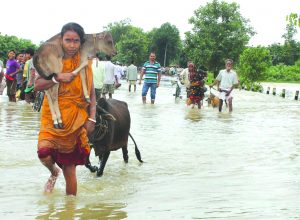 A report by Lancet, touted as world’s oldest and most prestigious medical journal released recently this month serves as the last call for the world and India, in particular. Battling rising population, poverty, poor healthcare and malnutrition, the threat is that much more challenging for India.
A report by Lancet, touted as world’s oldest and most prestigious medical journal released recently this month serves as the last call for the world and India, in particular. Battling rising population, poverty, poor healthcare and malnutrition, the threat is that much more challenging for India.
The 2019 report presents an annual update of 41 indicators across five key domains: climate change impacts, exposures, and vulnerability; adaptation, planning, and resilience for health; mitigation actions and health co-benefits; economics and finance; and public and political engagement. The report represents the findings and consensus of 35 leading academic institutions and UN agencies from every continent.
Understanding these decisions as a choice between one of two pathways — one that continues with the business as usual response and one that redirects to a future that remains “well below 2°C”— helps to bring the importance of recognizing the effects of climate change and the necessary response to the forefront. The world has observed a 1°C temperature rises above pre-industrial levels.
Eight of the ten hottest years on record have occurred in the past decade. Such rapid change is primarily driven by the combustion of fossil fuels, consumed at a rate of 171,000 kg of coal, 116,000,000 L of gas, and 186,000 litres of oil.
Effect on new born
A child born today will experience a world that is more than four degrees warmer than the pre-industrial average, with climate change impacting human health from infancy and adolescence to adulthood and old age. Across the world, children are among the worst affected by climate change. Downward trends in global yield potential for all major crops tracked since 1960 threaten food production and food security, with infants often the worst affected by the potentially permanent effects of under nutrition.
Children are among the most susceptible to diarrheal disease and experience the most severe effects of dengue fever. Trends in climate suitability for disease transmission are particularly concerning, with 9 of the 10 most suitable years for the transmission of dengue fever on record occurring since 2000. Similarly, since an early 1980s baseline, the number of days suitable for Vibrio (a pathogen responsible for part of the burden of diarrhoeal disease) has doubled, and global suitability for coastal Vibrio cholera has increased by 9·9 per cent.
Through adolescence and beyond, air pollution —principally driven by fossil fuels, and exacerbated by climate change — damages the heart, lungs, and every other vital organ. These effects accumulate over time, and into adulthood, with global deaths attributable to ambient fine particulate matter (PM) remaining at 2·9 million in 2016 and total global air pollution deaths reaching 7 million.
Later in life, families and livelihoods are put at risk from increases in the frequency and severity of extreme weather conditions, with women among the most vulnerable across a range of social and cultural contexts.
How India is affected
Globally, 77 per cent of countries experienced an increase in daily population exposure to wildfires from 2001–14 to 2015–18. India and China sustained the largest increases, with an increase of over 21 million exposures in India and 17 million exposures in China over this time period.
In low-income countries, almost all economic losses from extreme weather events are uninsured, placing a particularly high burden on individuals and households. Temperature rise and heat waves are increasingly limiting the labour capacity of various populations. In 2018, 133·6 billion potential work hours were lost globally, 45 billion more than the 2000 baseline, and southern areas of the USA lost 15–20 per cent of potential daylight work hours during the hottest month of 2018.
From 1990 to 2018, populations in every region have become more vulnerable to heat and heat waves. In 2018, these vulnerable populations experienced 220 million heat wave exposures globally, breaking the previous record of 209 million set in 2015.
The Paris Agreement has set a target of “holding the increase in the global average temperature to well below 2°C above pre-industrial levels and pursuing efforts to limit the temperature increase to 1·5°C.”
In a world that matches this ambition, a child born today would see the phase-out of all coal in the UK and Canada by their sixth and 11th birthday; they would see France ban the sale of petrol and diesel cars by their 21st birthday; and they would be 31 years old by the time the world reaches net-zero in 2050, with the UK’s recent commitment to reach this goal one of many to come.
Alternate for kids
 The changes seen in this alternate pathway could result in cleaner air, safer cities, and more nutritious food, coupled with renewed investment in health systems and vital infrastructure. This second path —which limits the global average temperature rise to “well below 2°C”— is possible, and would transform the health of a child born today for the better, right the way through their life.
The changes seen in this alternate pathway could result in cleaner air, safer cities, and more nutritious food, coupled with renewed investment in health systems and vital infrastructure. This second path —which limits the global average temperature rise to “well below 2°C”— is possible, and would transform the health of a child born today for the better, right the way through their life.
Global per capita use of electric vehicles increased by 20.6 per cent between 2015 and 2016, and now represents 1·8 per cent of China’s total transportation fuel use.
In several cases, the economic savings from a healthier and more productive workforce, with fewer health-care expenses, will cover the initial investment costs of these interventions. Similarly, cities and health systems are becoming more resilient to the effects of climate change; about 50 per cent of countries and 69 per cent of cities surveyed reported efforts to conduct national health adaptation plans or climate change risk assessments. These plans are now being implemented, with the number of countries providing climate services to the health sector increasing from 55 in 2018 to 70 in 2019 and 109 countries reporting medium to high implementation of a national health emergency framework.
Bold initiatives
 Bold new approaches to policy making, research, and business are needed in order to change course. An unprecedented challenge demands an unprecedented response, and it will take the work of the 7·5 billion people currently alive to ensure that the health of a child born today is not defined by a changing climate.
Bold new approaches to policy making, research, and business are needed in order to change course. An unprecedented challenge demands an unprecedented response, and it will take the work of the 7·5 billion people currently alive to ensure that the health of a child born today is not defined by a changing climate.
Across the world, an average temperature increase of 1°C from a pre-industrial baseline has already resulted in extreme climatic and environmental changes, with severe storms and floods, prolonged heat waves and droughts, new and emerging infectious diseases, and compounding threats to food security. Left unabated, climate change will define the health profile of current and future generations, will challenge already overwhelmed health systems, and undermine progress towards the UN Sustainable Development Goals (SDGs) and universal health coverage (UHC).
The health effects of wildfires range from direct thermal injuries and death, to the exacerbation of acute and chronic respiratory symptoms due to exposure to wildfire smoke. Additionally, the global economic burden per person affected by wildfires is more than twice that of earthquakes and 48 times higher than that of floods, although the global number of events and number of people affected by floods are much higher than for wildfires.
Onset of infectious diseases
 Climate change affects the distribution and risk of many infectious diseases. The 2019 Lancet Countdown report provides an updated analysis of the environmental suitability for transmission of dengue virus, malaria, and Vibrio, with the most recently available data, and presents an additional analysis of V cholera environmental suitability in coastal areas.
Climate change affects the distribution and risk of many infectious diseases. The 2019 Lancet Countdown report provides an updated analysis of the environmental suitability for transmission of dengue virus, malaria, and Vibrio, with the most recently available data, and presents an additional analysis of V cholera environmental suitability in coastal areas.
The carbon intensity of the energy system will need to reduce to near zero by 2050. Over the past 15 years, carbon intensity has largely plateaued, as the growth of low-carbon energy has been insufficient to displace fossil fuels. Coal phase-out is essential, not only as a key measure to mitigate climate change, but also to reduce morbidity and mortality from air pollution.
As of December 2018, 30 national governments, along with many sub-national governments and businesses, have committed to coal phase-out for power generation through the Powering Past Coal Alliance. Rapidly decreasing coal use to zero is crucial to meeting the commitments of the Paris Agreement. For example, no less than an 80 per cent reduction in coal use from 2017 to 2050 (a 5·6 per cent annual reduction rate) is consistent with a 1·5°C trajectory.
With the power generation sector accounting for 38 per cent of total energy-related emissions, the displacement of fossil fuels with renewable energy sources is of crucial importance. Globally, 3·8 million deaths per year are estimated to be attributable to household air pollution, largely arising from use of solid fuels, such as coal, wood, charcoal, and biomass, for cooking.
Efforts to provide clean cooking and heating technologies could result in substantial health co-benefits in addition to reducing greenhouse-gas emissions and short-lived climate pollutants. Exposure to ambient air pollution, most importantly fine particulate matter (PM), constitutes the largest global environmental risk factor for premature mortality, and results in several million premature deaths from cardiovascular and respiratory diseases every year.
Toddlers affected
More than 90 per cent of children are exposed to PM concentrations that are above the WHO guidelines, which can affect their health throughout their life, with an increased risk of lung damage, impaired lung growth and pneumonia, and a subsequent risk of developing asthma and chronic obstructive pulmonary disease.
Most of the exposure to PM results from anthropogenic activities, and much of this is associated with combustion of coal and other fossil fuels for electricity generation, industrial production, transport, and household heating and cooking; therefore, PM emissions share many of the same sources as greenhouse-gas emissions.
Malaria, Dengue endemic
Malaria and dengue fever are endemic in many parts of the world and, as described in the previous indicator, continue to contribute substantially to burden of disease, with young children particularly vulnerable. Suitability for transmission of mosquito-borne infectious diseases is affected by factors including temperature, humidity and precipitation.
For dengue, vectorial capacity, which expresses the average daily rate of subsequent cases in a susceptible population resulting from one infected case, is calculated using a formula including the vector to human transmission probability per bite, the human infectious period, the average vector biting rate, the extrinsic incubation period, and the daily survival period.
The second highest vectorial capacity for both dengue vectors were recorded in 2017, with the 2012–17 average 7·2 per cent and 9·8 per cent above baseline for Aedes aegypti and Aedes albopictus, respectively. This change emphasizes the continued upward trend of climate suitability.
For malaria, the number of months suitable for transmission of Plasmodium falciparum and P vivax malaria parasites is calculated on the basis of temperature, precipitation, and humidity. Furthermore, climatic changes, including increasing temperature and earlier snowmelt, contribute to hotter, drier conditions, which increase the risk of wildfires.
Yet, wildfires remain an important component of many ecosystems, although they can be ecologically harmful through human ignition or when forest management practices do not fully account for periodic, natural burning.
Other health issues
Many of the trends identified in the 2019 Lancet Countdown report are deeply concerning. Greenhouse-gas emissions continue to rise. The most immediate and direct impact of a changing global climate on human health is seen in the steady increase in global average temperature, and the increased frequency, intensity, and duration of extremes of heat.
The health threats include heat stress and heat stroke, acute kidney injury, exacerbation of congestive heart failure, and increased risk of interpersonal, and collective violence. In particular, during periods of extreme heat, young children have a greater risk of electrolyte imbalance, fever, respiratory disease, and kidney disease.
Also globally, crop yield potential for maize, winter wheat, and soybean has reduced in concert with increases in temperature challenging efforts to achieve SDG 2 to end hunger by 2030. The data suggests that global yields of these four key crops are reduced respectively by 6 per cent, 3·2 per cent, 7·4 per cent, and 3·1 per cent, globally for each 1°C increase in global mean temperatures.
Steps required
 Nevertheless, the continued expansion of renewable energy, increased investment in health system adaptation, improvements in sustainable transport, and growth in public engagement suggests ongoing reasons for cautious optimism. At a time when the UN Framework Convention on Climate Change is preparing to review commitments under the Paris Agreement in 2020, accelerated ambition and action is required in order to meet the world commitment to remaining “well below 2°C”.
Nevertheless, the continued expansion of renewable energy, increased investment in health system adaptation, improvements in sustainable transport, and growth in public engagement suggests ongoing reasons for cautious optimism. At a time when the UN Framework Convention on Climate Change is preparing to review commitments under the Paris Agreement in 2020, accelerated ambition and action is required in order to meet the world commitment to remaining “well below 2°C”.
The Intergovernmental Panel on Climate Change (IPCC)’s 2018 Special Report on Global Warming of 1·5°C emphasizes the scale of the response required: global annual emissions must halve by 2030 and reach net-zero by 2050 to limit warming to 1·5°C, while recognizing that no amount of climate change is considered safe.
Analysis focused on one of these pathways—cleaner air through more sustainable transport and power generation systems.
The threat is for real as efforts to reduce gaseous emissions fall short of the aim to keep the change in temperature at 2°C, as per the Paris agreement. The result of this failure is there for all to see in the form of Mother Nature turning hostile as brutal floods, raging wildfires, killing heat waves, melting glaciers — are the grim pointers to a deadly and dangerous future. Can we allow our kids to be burdened by the polluting after-effects of our reckless actions?
Rapid rise of deadly dengue, diarrhea, and other infectious diseases among children is a warning from nature to mend. We owe it our children to provide them a place to live in a healthy environment. We cannot ignore any more the ominous signs, the ugly portends.
letters@tehelka.com












